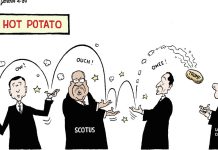EXCEPT for those familiar with their names, it might be a bit difficult to find anyone able to connect George Pence, Bob Marshall, Jean Prather and David Sechrest. Their lives span more than 150 years of Bartholomew County history. In fact, it is that history that binds the four.
Pence was the official county historian in the late 19th century. He compiled the 1888 history of the county.
Marshall and Prather were his 20th century counterparts. Bob, a former editor of The Republic, started to collect material for what would be the 2000 history of the county. After his death, that mission was taken up and completed by Prather, who was the newspaper’s society editor.
Following in all their footsteps is David Sechrest, who throughout the 21st century has been the go-to guy for those in search of information about the county’s history.
David came to the local history game relatively late in life. Ironically, one of his first ventures into the past was through a very modern medium — the internet. He single-handedly created the Historic Columbus Indiana website, which has not only evolved into an electronic repository for local history but has become an active chat room in which residents with long knowledge of the community have shared their information with others.
Although he hasn’t tackled anything so intimidating as an official county history, he has documented a number of important chapters in greater depth than anyone else. One of his earliest efforts stemmed from his love for and appreciation of the historic Crump Theatre. Fittingly the title of the book he published is “Columbus Indiana’s Historic Crump Theatre.”
More recently he has branched out into other areas of research. He was commissioned by Columbus entrepreneur and philanthropist Tony Moravec to write a history of Columbus’ old pump house, which reopened recently as a brew house/restaurant overlooking East Fork White River.
His most recent work deals with the history of Donner Park. The park history was originally to be a link to the centennial observance of the downtown green space this year, but David’s research has put a question mark in parentheses behind the so-called founding year of 1916.
Through his research, he has also brought into question the commonly held belief that the park is named after William Donner, a Columbus native who made millions of dollars in the steel business.
But David has taken the Donner Park story well beyond that of the steel magnate back to a time when most of Columbus was a woodland and the area in which the park is now sited was named Perry Park.
The Perry family made their grove available to the public for family entertainment and gatherings, such as the chautauquas that would be akin to today’s county fairs. They also served as sounding boards for the political candidates of the early 20th century. One of the most famous orators to speak at the Perry Park chautauqua was presidential candidate William Jennings Bryan in 1910.
The downtown park was also eyed for other kinds of development, one envisioning it as an ideal site for a new county hospital. Others saw it as a housing development that would require that the virtual forest of black walnut trees be taken down.
Fortunately, there were a number of tree lovers in the community, most notably a woman named Mary Donner, who lived in a mansion and property that took up all of a block encompassed by Seventh, Eighth, Washington and Franklin streets. She was wealthy in her own right, but her son, William, had done even better through his investments in Pennsylvania.
In the spring of 1916, it appeared that the future of what was then still Perry Park was limited. Local officials had begun preparations for removing all of the trees and subdividing the land into residential plots. Hearing of those plans, Mary Donner asked her wealthy son to purchase the land and donate it to the city.
That June, William Donner visited the park and agreed to purchase the land and turn it over to the city. The original plans called for a park dedication later that year, but a snag in negotiations pushed the official closing of the agreement into February 1917. No official dedication was ever held.
Although it has been commonly believed that the park was named in honor of William Donner, there is reason to believe that his mother at least deserves equal billing. Prior to the closing of the agreement, many in Columbus were asking that the park be named in her honor.
It’s facts like those that correct a lot of commonly held beliefs. Thank goodness there are people like David Sechrest around to keep our history accurate.
Harry McCawley is the former associate editor of The Republic. He can be reached at [email protected].




